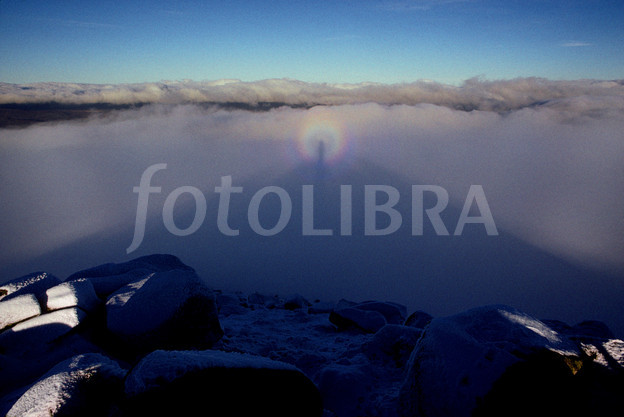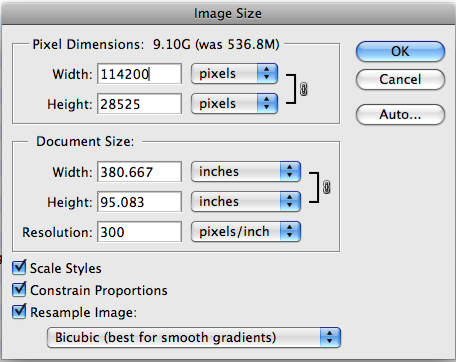Microstock: why would a reputable company do this to themselves?
April 7th, 2010by Gwyn Headley
Managing Director
The following blog posting was written by Chris Barton, managing director of PhotographersDirect.com. You can read the original post plus the comments it has triggered here.
We’re posting it on the fotoLibra Pro Blog (with his permission) because Chris has articulated the basic flaw in microstock and low value photography, and his blog needs to be read by photographers and picture buyers alike. When people don’t care — as these picture users clearly don’t — then cost becomes the sole criterion. Value means nothing.
Chris writes:
I was looking at a company website today, with the possibility of putting some business their way, when something I saw there made me cringe involuntarily.
They say a picture is worth a thousand words. Well, this one has a lot to say. It says microstock. It says perfect-people perfect-world lowest-common-denominator cookie-cutter pile-them-high sell-them-cheap image.
Why would a reputable company want to be associated with those words?
The problem with this image is that it has that…. ‘Deja Vu’ feeling to it, and for a good reason.
So, do these guys come as a package? Have they moved on from “Best of the Web” to form the Corporate Team at “123 Greetings”?
As you would expect from such a high powered team, they speak fluent German…
… and some oriental language – you could probably find out which one if you bump into them at the:
and of course they come with a:Now, this may all just seem a bit of a joke, just poking fun at the short-sightedness of companies using cheap microstock images to represent their… well, image, but when it gets visibly misleading:
About us? They didn’t do a very good job of spotting this trouble on the horizon…
maybe financeme needs better financing if they don’t have any headshots of their own staff and can only afford microstock images…
I think that should read ‘Company Oversight’
…you end up questioning the credibility of the company itself.
I don’t believe these people really work at Targetti Poulsen…
…so why would I trust anything else that Targetti Poulsen have to say?
And if I am wrong and they do work there, are Targetti Poulsen aware that their ‘people’ moonlight at:
On a side note, ‘Bad Credit Cosmetic Surgery Loans dot co dot uk’ wins this month’s prize for “dodgiest domain name”.
My final example I think rounds off this topic in an appropriate way:
from their track record, getting these ‘good people’ to stay does not look promising…
Okay, so HireView Magazine used the same silly microstock image. But that photo at the top? That’s them. That’s the team at HireView. I am confident about that because it isn’t a perfect-people perfect-world lowest-common-denominator cookie-cutter pile-them-high sell-them-cheap image that has spread across the internet like a nasty virus. It is an honest picture, and because of that, I think I can trust HireView Magazine.
Which is more than I can say for the rest of these companies.
Companies need to think more carefully about the images they use. I suspect many businesses are unaware that the photos their designer has sold them are spread a-dime-a-dozen across the web. There is a good reason that microstock’s original catchphrase was “the designer’s dirty little secret”.
At the very least, reputable companies should look at using rights-managed rather than royalty-free images, so they will KNOW if the image is being used elsewhere and whether a competitor (or sometimes something even worse: “Cosmetic Surgery for mens, Get your Dream Shape like stars”) is using the same ‘team’ to represent their company. Or maybe they should follow HireView Magazine’s lead and actually hire a photographer to take real pictures of real people who work at their company. They may not be perfect, they may cost a bit more, but they will look genuine, and honest. And not just… cheap.
Thank you Chris — firstly for your permission to reproduce your blog here, and secondly for your righteous indignation at the short term, penny-pinching attitude of so many organisations. To mangle John Donne: “Every microstock sale diminishes us, because we are part of the photographic community.”
Standards? What standards?
Mountains into Molehills
April 1st, 2010by Gwyn Headley
Managing Director
fotoLibra member John Cleare is a world-famous mountain photographer who made his reputation long before fotoLibra was even a gleam in my eye, so we can claim no credit for his fame, alas. Indeed, I handled the publicity for one of his mountain books back in 1979, so he knows whereof he writes (and shoots).

Brocken Spectre, Lochnagar ©John Cleare / fotoLibra
–
He sent me an email yesterday, lamenting the decline in standards of captioning, and I agree with every word.
I’ll share with you my indignation at the use, all too frequent these days, of wrongly captioned pictures by the media. It’s my current pet gripe, and I could recount a series of ghastly gaffs that I’ve noticed since digitisation became the norm.
Only the other day the Daily Telegraph ran a major travel feature on skiing at Lake Louise in the Canadian Rockies, illustrated by a (very nice) picture of Moraine Lake, which of course is somewhere else and is well known and easily recognisable to boot. Naturally I take note of the many pictures of Everest that I come across in the media — from the Times, to the BBC, to my wife’s magazines. Some 30% or more are not Mount Everest, yet are captioned as such. Colleagues tell me such happenings are all too frequently seen in their own fields too.
Is it that the photographer doesn’t caption the material properly ? Is it that Mr Getty doesn’t care ? Is it that the Picture Editor doesn’t care ?
I can’t see it happening with the fotoLibra system !
I’ve moaned about the matter to BAPLA many times over recent years but of course they can do little about it except to encourage “TRUTH”.
At the risk of blotting my copybook, I’ve moaned to guilty (?) picture editors and researchers in several really blatant cases. Even when we’ve known each other by name, in only one case has there ever been a response — and that was claiming the caption supplied was incorrect.
It may well have been true, but it’s as good excuse as any.
Thanks to digitisation, the whole picture industry has changed so much in recent years that the days of the small, specialist independent are in the past, perhaps fortuitously at a time when folk seem surprised that I’ve not retired long since. But of course like mountaineering, making pictures is a way of life from which one can never retire — I’ve done five books in the past eighteen months and led one excellent small expedition, although I suppose I shall gradually fade away in due course.
I do like the fotoLibra system, and for someone busy like myself, responding to specific picture calls is a convenient way to operate, besides airing pictures that no one would ask me for in the normal way, given my specialist reputation.
John has hit the nail on the head. There is a lot of sloppy work out there, and I don’t know whether it’s because people are too busy, overworked, stressed, tired, drugged, drunk or because they simply don’t care. Forty years ago if you did something wrong you got sacked. That can’t happen now.
And thank you John for your very kind comments about fotoLibra but the unpalatable truth is that it could occasionally happen. I don’t think many of our staff could readily distinguish between Moraine Lake and Lake Louise, so we have to rely on the accuracy of our members. We’ll correct errors where we’re sure we’re right (the Eiffel Tower is not white, circular and leaning), and thanks to the brilliant Colin Smedley our aviation photographic captions are the most accurate in the picture library world — but in the end we have to rely on the photographer.
Let’s work together to turn this picture captioning mountain into a molehill. For our part, it’s down to us to ensure the captions and keywords we give to our images are as precise and as accurate as possible. After they’re sold, publication is out of our hands — we can’t afford to go to the printers and stand over the Heidelbergs — but if the final image appears wrongly captioned or attributed, we can and always do make our displeasure strongly known to the buyer.
Don’t mess with fotoLibra members’ photographs!
autoFocus
March 18th, 2010by Gwyn Headley
Managing Director
In her latest Newsletter Jacqui Norman reveals another new fotoLibra feature which is actually still on the drawing board.
It’s called autoFocus, and it’s envisaged as a rolling newsfeed of stories of interest to to picture buyers and photographers. I want it to appear as a tickertape band rolling across the screen but apparently there are technical problems with that which, though surmountable, are too development time intensive to commit to. We will see.
In whatever form it eventually appears it will feature stories drawn from a glittering variety of sources, from our favourite personal blogs to authoritative statements and declamations from industry bodies. Of course it will have to be selective simply because of the sheer volume of information available on the net, but it will not favour money, influence and brand loyalties over iconoclasm, plaudits, discoveries, brickbats and advice, or indeed vice-versa. It will not take sides on Canon vs. Nikon debates (or Exakta vs. Thornton-Pickard for our Heritage members).
But as you will realise these are all fine thoughts during work in progress. What we finally release may be quite different, but whatever happens it will only be as good and as useful as its source material. We want to make this as broad ranging as possible.
If you enjoy a photo blog, forum or website, and better still if you run or write one, please let us know so we can add it to autoFocus. Obviously it must have an RSS or Atom feed enabled, but don’t you worry your pretty little head about that, we’ll check it out.
We very much hope you’ll all enjoy it and find it useful, and we also hope you’ll tell us what you want to see.
Links You May Have Missed
March 17th, 2010by Gwyn Headley
Managing Director
At the end of every year we do a round-up of all the fotoLibra Pro Blog postings throughout the year. Though we say so ourselves, it’s a useful reference to the way fotoLibra works.
Two articles in particular should be read by every fotoLibra member:
GREAT EXPECTATIONS tells you precisely what to expect when you go on line to try and sell your photographs. It’s based on the fotoLibra experience, but we don’t think it’s going to be that much different from any other agency.
THREE HUNDRED PIXELS PER INCH tells you why this is an upload requirement for fotoLibra, and how to achieve it. Yes, we do know resolution is an irrelevance as far as screen-based media goes, but read the piece carefully and you may just comprehend why we demand it.
So we’ve happily been sending links to these and other various blog postings, only to find people complaining they’re always directed to the same (and not necessarily relevant) entry.
The reason appears to be that we used bit.ly to abbreviate the URLs of our blog postings. We never knew it had a restricted shelf life, but certainly on the fotoLibra site all the carefully input bit.ly abbreviations over 6 months old defaulted to the most recent blog post.
So we’ve laboriously rewritten the links coding for the fotoLibra 2009 Pro Blog Index for the whole of 2009.
And now it should work for you. Sorry!
More Microstock Moans
March 16th, 2010by Gwyn Headley
Managing Director
I really can’t get my head around microstock websites. The bit I can’t understand is why the participating photographers think so little of their work that they’re prepared to value it so cheaply.
Someone recently asked on a Canon forum “Has anybody had experience of using Fotolibra to sell pictures?” Having just helped send out over 100 sales notifications so far this week I thought I could answer that, but my application to sign up to the forum has not yet been verified.
Someone wrongly assumed fotoLibra was a microstock site and posted an answer linking to three blogs recounting experiences with these kinds of agencies. They weren’t universally positive. Out of interest, here they are:
Microstock Tips | Pixels Away | Erik Kolstad’s Blog
They are not right up-to-the-minute (the market has almost stiffened and died since these figures) but none the less I am astounded at how little these supplying photographers are prepared to accept. Have they no pride in their work?
One wrote:
I’m a climate scientist in Bergen, Norway. Starting in 2008, I have been contributing to a number of stock photography sites. I started out with iStockphoto, and after a while I joined Shutterstock and Dreamstime as well. Now I have quit Shutterstock, largely because of their ridiculous royalty scheme (they pay you $0.25 for each customer download). I’m currently trying out SnapVillage, Fotolia, 123rf.com and the German agency PantherMedia.
I couldn’t help but respond, although unfortunately I do sound a bit sniffy from time to time:
May I correct you? You are not actually trying out stock photography sites, you are trying out MICROstock photography sites.
Proper picture libraries such as fotoLibra.com sell fewer images than the microstock sites because we value the work of photographers more highly, and therefore charge accordingly.
You would probably only sell a fiftieth of what you could sell on a microstock site through fotoLibra.
But you would probably earn a hundred times as much.
Our average picture sale for a rights managed image is €56 / $77 / £51. Standard fotoLibra photographers get 50% of that.
So one fotoLibra sale would normally net you $38.50 / £25.50. That’s the equivalent of 154 sales through Shutterstock.
I think that’s a very compelling argument. I have no doubt the microstock apologists will disagree.
Up To 20Mbps Broadband
March 10th, 2010In fotoLibra’s offices in London and Harlech we use Zen as our service provider, and we have no complaints about them at all. In fact we can heartily recommend them, having used them for the past five years.
They’ve just upgraded our broadband service from 8Mbps to “up to 20Mbps”, which is very exciting.
Before they upgraded us I tested our speeds. It averaged 4.79Mbps download, and 0.36Mbps upload. That’s ADSL for you; if we had straightforward Digital Subscriber Lines like they do in Germany instead of Asymmetric Digital Subscriber Lines,we’d be able to upload and download at the same speed.
That’s why downloading an image from fotoLibra is over 13 times faster than uploading an image to us. We’re sorry, but unless you’ve got DSL there’s not a lot we can do about it.
Back to our “up to 20Mbps” upgrade. It came on stream this morning, so I tested our speeds again.
6.23Mbps download, 0.67Mbps upload. Not as thrilling as I’d hoped. That’s 31% of the potential speed. We were getting 60% of our potential speed on the previous deal. Why should the percentage decrease so greatly?
Still, it’s a little faster, so that is a good thing.
But have you noticed that “UP TO” always actually means “LESS THAN”?
Privacy
March 9th, 2010We received the following email this morning:
As the owner of this rare car, I would request that this image be deleted from this site on the grounds of privacy.
If my car was parked outside my house and it was captured on Google’s street maps facility, at least they respect an individual’s privacy by blurring out vehicle licence plates. This aspect also extents to images in the media such as newspapers and TV broadcasts.
Additionally, I was not approached or contacted regarding the inclusion of my car for a third parties financial gain.
I agreed to appear at this show because the organiser of this event is a personal friend.
Please respect my request – thank you.
This is a perfectly polite and reasoned request. But what is at stake here? We’re under no obligation to take down images because the subject of the photograph objects to his property being depicted. If he doesn’t want his car to be seen he shouldn’t take it out in public.
Yes, the photograph was posted on fotoLibra for the purpose of financial gain. We haven’t yet found someone who is planning a calendar of AC cars, but we always live in hope.
You can’t stop anyone taking and publishing a photograph of your house, and it’s a lot easier to find out who lives in a house than who owns a car. Just check the electoral roll, or the census. We as private individuals can’t find out who owns this car by looking at the registration plate (which we’ve pixelated out here).

©Geoff Alan France / fotoLibra
But private parking companies can get a driver’s name and address simply by submitting the vehicle registration number to the DVLA and filling in a form confirming that they are pursuing an alleged parking offence.
The DVLA charges £2.50 a time for details from its ‘confidential’ database of 38m drivers. Income from this lucrative sideline in selling our personal data has risen every year from £4.7million in 2004-5 to £9.2m for 2009-10.
The owner of the car might find more reason to complain about this collaboration than about an enthusiastic photograph in a picture library.
What do you think?
Why DPI Does Matter
March 4th, 2010by Gwyn Headley
Managing Director
I was pointed to a couple of blog postings yesterday, one called The Myth of DPI and the other titled Why DPI Does Not Matter.
Their arguments are logical and faultless. Their reasoning is sound. The message they are trying to get across is correct. But they are both wrong.
So why are they wrong?
Because they are writing about images on the web, and mentioning DPI. When you set the image size and resolution in Adobe Photoshop you never have the option of choosing the DPI of an image. This is what you get if you choose inches as your preferred units:

and this is what you get if you choose metric:

The option you have is of choosing “pixels/inch” or “pixels/cm”. Not “dots/inch” or “dots/cm”. Adobe Photoshop is concerned about your digital file. It doesn’t give a monkeys what you intend to do with it later. So it offers you ppi, NOT dpi, which is used in printing terminology. 300 pixels per inch equals 118.11 pixels per centimetre.
Our earnest bloggers are absolutely right in that ppi is irrelevant when you’re showing images on a screen. But dpi is relevant when you print those images, because then you can figure out how large you can print the image before those annoying little pixellations get in the way and become visible. 300 dots per inch is generally enough for the human eye to be tricked into seeing continous tone.
fotoLibra has always demanded that images uploaded to its site should be 300 ppi, for two perfectly valid reasons — and one utterly compelling one. You can read about them here.
I agree with my friends Ben Gremillion and Svein Wisnaes that resolution counts for nothing on the web. So it generally doesn’t matter, until you come to selling your photographs. When you are selling photographs to book publishers who need to print them at 300 dots per inch, it’s common courtesy to supply them at 300 pixels per inch.
Otherwise they might buy them from someone who took the trouble to go the extra step.
eBook Pricing
February 15th, 2010by Gwyn Headley
Managing Director
I needed to brush up on my SEO (Search Engine Optimisation) awareness so I thought I’d buy an ebook on the subject, instead of waiting around for the print version to arrive.
Because if anything’s got a short shelf life it’s going to be a book about how to improve your web site.
As I’m a member of a thriving LinkedIn community called “Ebooks, Ebook Readers, Digital Books and Digital Content Publishing” I thought I’d solicit the help of my fellow members and so I asked them “Can anyone recommend a good ebook about SEO? ANY ebook on SEO seems to be hard to find.”
They responded generously. I chose “SEO Warrior” by John Jerkowicz, for two reasons: it was the most recently published book on the subject (see comment above about short shelf lives) and it was published by O’Reilly, a trusted name in computer publishing.
It was suggested by Jill Tomich, the CEO of eBookPie, together with a link through to the page on her site where I could buy it: http://bit.ly/bLhQ7F. This was great. Just what I wanted. It was only $30.69.
But something made me pause. When I got my iPhone, I bought the O’Reilly “Missing Manual for the iPhone”. And it cost me £2.99. So I went to the iTunes store and found 600+ O’Reilly titles ranging from free (free is a price point) to £3.49. And there was “SEO Warrior” for £2.99.
Reader, I bought it.
Now everyone knows that O’Reilly are smart guys. Perhaps they can explain to me the following price structure for “SEO Warrior”:
Recommended retail price, USA:$44.99, UK £34.50
Print copy, Amazon USA: $29.69
Print copy, Amazon UK: £18.41
eBook, eBookPie USA: $30.69
eBook, iTunes App Store UK: £2.99
As an App developer myself (Aaron’s Time Machine: New York will very shortly be released) I know that Apple take 30% from the sale of any app. So what’s the thinking behind O’Reilly selling the same product (OK, in different formats) at prices ranging between $44.99 and $4.69? A near tenfold difference? How does the author feel about his royalty?
Please tell me. I’m really curious.
Yes, I feel bad about not buying it from Jill Tomich’s site, as she was so kind as to point me to it. But not as bad as I’d have felt if I’d paid $30 for the ebook and an hour later found it being sold for £3.













